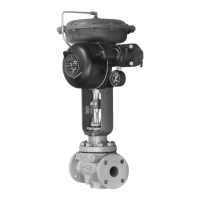Instruction Manual
D200108X012
546 Transducer
March 2015
11
the opposite action. Whenever the action is changed, readjust the zero of the transducer as outlined in the
adjustments procedures.
Split Range Operation
546 transducers are suitable for two‐way split range operation. In a two‐way split the milliampere (mA) or voltage
output signal of a single control device is split between two transducers electrically connected in series. Although each
transducer receives the full signal, it is calibrated to provide a full output pressure range of 0.2 to 1.0 bar (3 to 15 psig)
or 0.4 to 2.0 bar (6 to 30 psig) to the control valve with one‐half the input signal. Since the transducer operates on only
one‐half of the normal input span, the feedback bellows must be changed to compensate for the shorter span. Change
the bellows as described in the replacing feedback bellows assembly procedure in the Maintenance section. Table 6
indicates which bellows is required for your conditions. Reset the span and zero adjustments to the split range values.
Note that these transducers cannot provide a three‐way split range.
Table 6. Feedback Bellows Output Pressure Range
OPERATION INPUT SIGNAL, DC
BELLOWS SIZE
Full Half Quarter
Bar Psig Bar Psig Bar Psig
Full Range
1 to 9 V
(1)
4 to 20 mA
10 to 50 mA
0.2 to 1.0 3 to 15 0.4 to 2.0 6 to 30 - - - - - -
Split Range
4 to 12 mA or 12 to 20 mA
10 to 30 mA or 30 to 50 mA
1 to 5 VDC or 5 to 9 VDC
- - - - - - 0.2 to 1.0 3 to 15 0.4 to 2.0 6 to 30
1. Temperature compensated circuit.
Principle of Operation
Refer to the schematic drawing in figure 6. Assume that the transducer is direct‐acting. An increase in the DC signal to
the coils increases the magnetic field around the coils. This field increases the magnetic strength in the armature and
the magnetic attraction across the air gap between the armature and the pole pieces.
The pole pieces are already polarized by the permanent magnet. The armature polarity is as shown in the schematic.
The magnetic attraction will therefore be downward at the nozzle end and upward at the feedback bellows end,
resulting in a torque that rotates the armature about the fixed torsion rod to cover the nozzle. The resulting restriction
produces an increased pressure in the nozzle, in the upper chamber of the relay, and in the feedback bellows. The relay
responds to the increase in nozzle pressure to increase the output pressure to the actuator and control valve. The
increased pressure in the feedback bellows creates a force that acts on the armature to move it back to an equilibrium
position. In this way, the new nozzle pressure is compared to the input current by the force‐balance principle.
The relay operates in the following manner. The nozzle pressure acts on the large top diaphragm to force the center
spacer assembly (mounted between the two diaphragms) downward against the valve plug, closing the exhaust port
and opening the supply port. Supply air then flows through the open port to the output load. The output pressure
continues to increase until the relay diaphragm assembly is pushed back to its original position by the force of the
pressure acting on the small diaphragm. When this occurs, the valve plug is closed again.
When a decreasing DC signal is received, the magnetic attraction across the air gap is reduced. The armature rotates
to uncover the nozzle and decrease the pressure in the nozzle, relay, and feedback bellows. The relay diaphragm
assembly moves upward, and the exhaust port opens to bleed the output pressure to atmosphere.
The output decreases until the diaphragm assembly is forced back to its original position and the exhaust port is closed
again. The reduced pressure in the feedback bellows diminishes the force to return the armature to the equilibrium
position.

